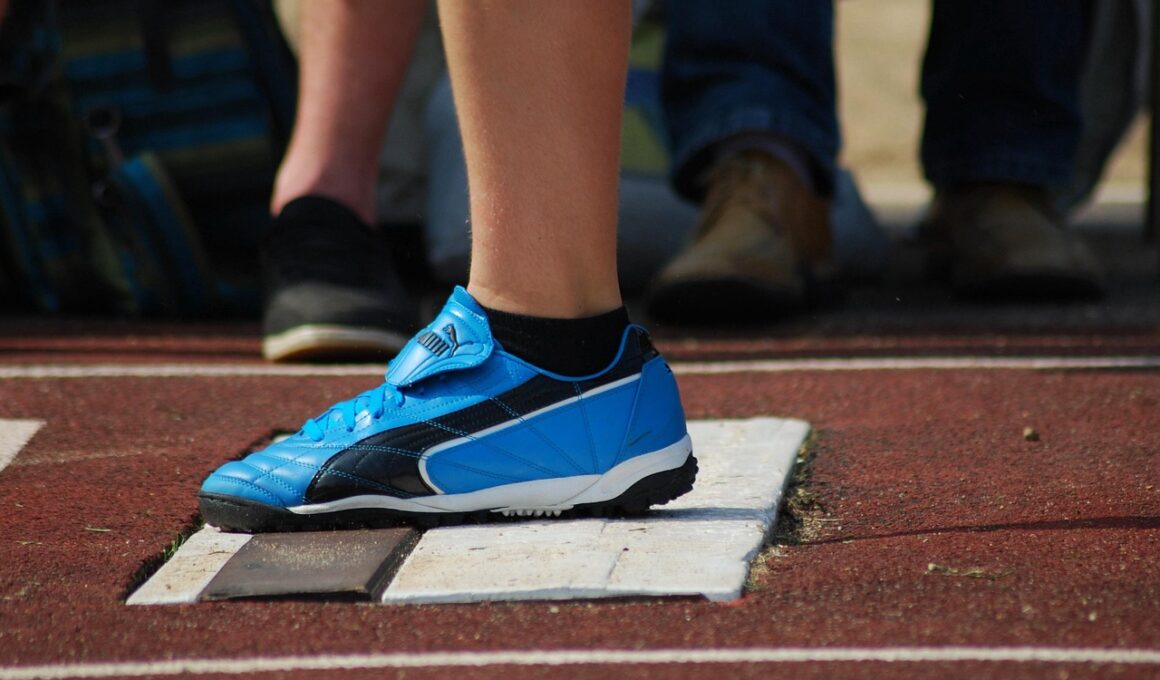Enhancing Explosive Power in Jump Events: Coaching Tips and Drills
Explosive power is critical in track and field, especially for jump events like the long jump and high jump. Coaches must focus on exercises that develop strength and speed simultaneously. Plyometric training, which includes activities such as jump squats and bounding, enhances muscle power. Strength training exercises such as squats and deadlifts build the necessary strength to propel athletes off the ground effectively. Include drills that simulate the jumping motion to improve not just strength, but also the technique needed for efficient height and distance achievement. Proper nutritional guidance is also vital; athletes need to fuel their bodies with the right nutrients to support muscle growth and recovery. Additionally, coaches should include agility work in their programs to enhance the overall athletic performance of their athletes. Creating a balanced training program that integrates strength, speed, and technical skills will undoubtedly yield better results, improving not only performance but also reducing injury risks. All athletes must maintain a positive mindset and stay motivated, enhancing their training experiences and outcomes, ultimately working towards reaching their peak performance levels.
One essential aspect of enhancing explosive power in jump events is biomechanics. Understanding how an athlete’s body moves during a jump can greatly influence their performance. Coaches should video record jumps to analyze technique and provide feedback. Proper posture, foot placement, and arm swings are critical elements to observe. Teaching the right technique can maximize an athlete’s power output, which is crucial for all jump events. Coaches should also educate athletes on the importance of practicing controlled landings, as this will not only improve performance but also avoid injuries. Integrating visualization techniques can help athletes mentally prepare for jumps, enhancing focus and timing. Drills should involve specific routines that simulate competition preparation for jump events. This preparation fosters both mental resilience and physical readiness. Additionally, warm-ups, cool-downs, and stretching should not be overlooked, as these routines can significantly impact an athlete’s performance. The combination of all these factors will contribute to the overall development of an athlete’s jumping capabilities, equipping them with the physical tools they need to excel in track and field jumping events.
Specific Drills for Explosive Power
Several specific drills can be implemented into training regimens to stimulate explosive power. Box jumps are excellent for building this strength, offering a direct method to enhance an athlete’s vertical leap. To execute a box jump, the athlete squats, then explosively jumps onto a box, activating their core and lower body muscles. Another effective exercise is the depth jump, where athletes step off a box and jump upon landing, training the muscle response necessary for optimal performance. Bounding drills also promote speed and power; athletes cover as much distance as possible while hopping forward. Use sprint drills that emphasize short bursts of speed intertwined with jump exercises to maintain high heart rates. Resistance training with bands can add an extra challenge by creating resistance against movements, effectively increasing strength. Coaches should schedule these drills at various points in the week, allowing for the body to adapt to increased training loads. Monitoring the athletes’ progress is vital, as it helps identify when adjustments need to be made to prevent plateauing, ensuring optimal results in performance.
In addition to strength and explosive power training, coaches must focus on recovery protocols to optimize athletes’ performance. Adequate rest periods, hydration, and nutrition play vital roles in supporting the physical stress placed on athletes during training. Implementing recovery strategies such as foam rolling, massages, or guided stretching aids in reducing soreness and preventing injury. Understanding when to scale back training intensity and volume is essential. Periodization, a systematic training plan that cycles through different phases of training, can effectively manage this, allowing peaks and recovery periods for athletes. Coaches should educate athletes on recognizing their bodies’ signals, knowing when they’re fatigued and need additional rest. Encouraging athletes to engage in mindfulness practices or yoga can also improve mental strength and focus. Ultimately, maintaining physical and mental wellness is vital for athletes aiming to optimize their performance. Regular evaluations of coaching methods and training routines will help to ensure adjustments are made where necessary, keeping the training dynamic and effective, leading to continuous improvement and successful outcomes in jump events.
Integrating Competition Preparation
Preparing for competitions entails more than just physical readiness; mental preparedness is crucial as well. Coaches should devise strategies to help athletes cope with competition pressures. Simulating competition scenarios during practice helps in familiarizing athletes with the environment. This could include performing jumps with a crowd present or under timed conditions. Additionally, coaches can provide mental imagery techniques, allowing athletes to visualize their jumps, which helps build confidence. Consistent encouragement and constructive feedback after jumps instill a sense of achievement that can be pivotal before competitions. The way athletes perceive their abilities directly affects their performance, so it’s essential to build a positive environment. Establishing team-building activities fosters camaraderie, enhancing athletes’ relationships and support systems on competition day, which can improve overall morale. Coaches should emphasize the importance of setting realistic goals for themselves and focusing on individual performance regardless of the competition. Creating an overall competition plan that delineates what to focus on can reduce anxiety and improve focus, leading to superior performance. This holistic approach ensures athletes are mentally and physically ready to showcase their best abilities.
The period after competitions serves as an important recovery phase for athletes. Coaches should implement transition periods where training intensity is reduced, allowing athletes to recuperate from physical exertion and mental fatigue. This phase is crucial for maintaining athletes’ motivation and preventing burnout. During this time, coaches can also focus on skill refinement and technique adjustments based on competition performance. Assessing the techniques from previous jumps and discussing areas for improvement aids athletes in setting new goals for the upcoming season. Athletes can also engage in cross-training activities such as swimming or cycling to maintain fitness levels while providing varied movement patterns. Emphasizing the enjoyment of the sport, rather than just performance metrics, is key in maintaining athletes’ enthusiasm. Team bonding activities can strengthen relationships and help athletes reflect on their experiences, emphasizing learning from challenges. This focus on both physical recovery and emotional well-being contributes to building resilient athletes. Proper planning for recovery and off-season training ensures athletes return stronger and better prepared for future competitions, setting a solid foundation for successful performances in the next jump season.
Conclusion and Future Directions
In conclusion, enhancing explosive power in jump events requires a comprehensive approach that integrates strength training, technique, mental preparation, and recovery. Coaches have the responsibility to not only design effective training programs but also to foster supportive and positive environments for their athletes. Continuous learning for coaches through updated methodologies can also contribute to their athletes’ success. Keeping abreast of advancements in sports science and training techniques is vital for optimizing performance. In future directions, the integration of technology such as motion analysis and biomechanical feedback can provide greater insights into athletes’ performances. Coaches can utilize wearable technology to gather data during training sessions, helping refine training programs. Keeping in touch with current trends, such as holistic approaches to athlete wellness, may also enhance the comprehensive development of jump athletes. As sports evolve, so must coaching strategies, continually adapting to support the athlete’s journey towards peak performance. A commitment to ongoing development and understanding athletes’ unique needs will lead to a successful track and field coaching experience.
In summary, the journey to improve explosive power in jumping events requires dedication and a tailored approach. Coaches should relentlessly test different drills while continually evaluating their effectiveness. Jump athletes benefit from well-structured training regimens that cover speed, strength, and technique consistently. Furthermore, integrating sports science and innovative training methods ensures athletes are kept engaged and challenged. By establishing clear communication and fostering relationships built on trust, coaches inspire athletes to reach their potential. Commemorating small victories helps sustain motivation throughout their training journey. The perfect balance of mental resilience and physical capability peaks with continued practice. Ultimately, a strong coaching relationship and proper methodologies will lead athletes to achieve impressive results in jump events like high jump and long jump. Coaches who prioritize aspects like biomechanics, recovery, skills, and competition strategies prepare their athletes to succeed at the highest levels. Looking forward, it’s crucial to remain adaptable in training styles, accommodating athletes’ growth and emerging sports sciences. With this proactive approach, both coaches and athletes will navigate the challenges of competitive track and field together, aiming for future triumphs. Exciting opportunities await aspiring jumpers and their coaches.





